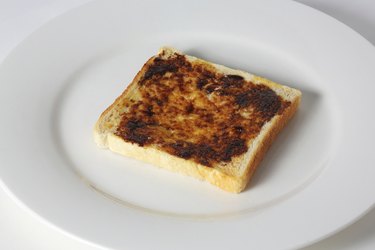
While not commonly found in the United States, Marmite is a spread made from brewer's yeast that is popular in the United Kingdom. This salty paste has a devoted following in many parts of the globe, but others despise it because of its strong, meaty flavor. You can find jars of Marmite in stores that import British foods and taste it to decide for yourself whether you love it or hate it.
The History of Marmite
Video of the Day
In the late 19th century, Justus von Liebig was the first scientist to discover that yeast could be concentrated and bottled into an edible product. In 1902, that's what the Marmite Food Company did when it started producing Marmite, a savory spread made with the yeast by-products of local breweries. Prior to this time, these by-products had simply been discarded. Marmite gets its name from a type of French pot in which the spread was first sold. The original plant, in Burton-on-Trent, Staffordshire, continues to produce Marmite in 2014, although the company is now owned by Unilever, that bought the brand in 2000.
Video of the Day
What's In It?
Marmite contains the yeast that remains after being used to brew beer, which is then mixed with salt and heated to soften the cell walls of the yeast. Once the mixture thickens, it is strained to make it smooth and then mixed with spices, celery extract and vegetable extract to form a dark, sticky, spread. The formula has changed over the years and is now fortified with vitamin B12, niacin, thiamin, folic acid and riboflavin, according to Wired.co.uk. Because of its vitamin content, Denmark has classified it as a vitamin-enhanced foodstuff and retailers require special approval by the Danish Food and Veterinary Administration to sell it.
Love It or Hate It
Marmite has a strong, very salty taste with a tangy, bitter bite. Due to the yeast content, the spread has a rich, savory flavor found in many fermented foods and mushrooms. Some vegetarians use it to add a meat-like flavor to dishes as it does not contain any animal-based ingredients. With its pungent aroma and taste, Marmite is not for everyone. Part of the advertising for the spread has included the phrase "love it or hate it" because it is a very polarizing product. Some countries, including Australia and New Zealand, produce a different version of Marmite which uses the same name, but contains caramel and sugar to give it a more pleasant, sweet and mild flavor.
How to Use Marmite
Marmite is considered a condiment that most people spread thinly on toast, sometimes along with butter. You can also use it as a sandwich spread, usually in cheese sandwiches, just as you would mustard or mayonnaise. Stir it with warm water to make a beef-like flavored broth or a tangy sauce for meats. Add it to stews to enhance the meaty flavor. Mix a little Marmite into bread dough to give it a malty flavor or include a bit of it in your desserts as a counterpoint to sweetness. Marmite works well as an addition to caramels, custards and puddings to enhance their savory flavor. Store Marmite in the pantry, where it can last for years.
- Unilever: Marmite
- BBC: Marmite: Ten Things You'll Love/Hate to Know
- Wired.co.uk: What’s Inside: Marmite
- International Business Times: What's Really in Marmite and Why is it Banned?
- The Guardian: Umami: Why the Fifth Taste is so Important
- The Guardian: How Marmite Spread its Way Through Journalism
- The Kitchn: Sticky and Savory: 7 Recipes With Marmite (...or Vegemite)
- The Telegraph: Marmite: The Latest Superfood?